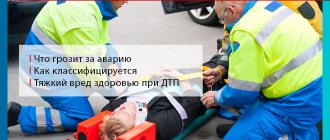1. Destruction, damage or otherwise rendering unusable a vehicle, communication lines, signaling or communication means or other transport equipment, as well as blocking transport communications, if these acts negligently resulted in the infliction of grave harm to human health or the infliction of major damage - shall be punishable by a fine in the amount of one hundred thousand to three hundred thousand rubles, or in the amount of the wages or other income of the convicted person for a period of one to two years, or by forced labor for a term of up to four years, or by imprisonment for the same term.
2. The same acts, which through negligence resulted in the death of a person, are punishable by imprisonment for a term of up to eight years.
3. Acts provided for in the first part of this article, resulting in the death of two or more persons through negligence, are punishable by imprisonment for up to ten years.
Note. In this article, major damage is defined as damage the amount of which exceeds one million rubles.
Art. 267 of the Criminal Code of the Russian Federation
Violations include damage, breakdowns, rendering unusable vehicles or their elements, as well as roads, communications and other transport communications (for example, making changes to aircraft engines, dismantling railway tracks, theft of basic elements of a car, damage to shipping vehicles and other). A crime is considered only in the event of harm to human health or property damage. If damage to a shipping vehicle leads to the loss of cargo, as well as the death of citizens, several elements of crime are identified and an inspection is carried out, according to which a decision is made to initiate a criminal case under this article.
This article of the Criminal Code is divided into three parts, each of which provides for penalties. The least of them is part one, which carries up to 2 years of imprisonment. The largest penalty is imprisonment for up to ten years if the crime resulted in the death of several people. Thus, the crime is classified as serious.
The court may impose a suspended sentence if minor harm was caused.
Judicial practice: sentences and punishment under Art. 267.1 of the Criminal Code of the Russian Federation
- Resolution of the Plenum of the Supreme Court of the Russian Federation dated... PLENARY OF THE SUPREME COURT OF THE RUSSIAN FEDERATION DECISION dated December 27, 2002 N 29 ON JUDICIAL PRACTICE IN CASES OF THEFT,...
- Decision of the Supreme Court: Determination N 203-APU17-21... THE SUPREME COURT OF THE RUSSIAN FEDERATION Case No. 203-APU17-21 APPEAL DECISION Moscow August 31, 2021 Judicial Collegium for Military Personnel of the Supreme...
- Decision of the Supreme Court: Resolution No. 310P13 dated... DECISION OF THE PRESIDIUM OF THE SUPREME COURT OF THE RUSSIAN FEDERATION Case No. 310-P13 Moscow January 23, 2014 Presidium of the Supreme Court of the Russian Federation...
- Judicial Collegium for Criminal Cases, appeal:... THE SUPREME COURT OF THE RUSSIAN FEDERATION Case No. 72-APU 17-21 APPEAL DECISION Moscow October 04, 2021 Judicial Collegium for Criminal Cases...
- Decision of the Supreme Court: Determination No. 56-КГ16-46 dated... THE SUPREME COURT OF THE RUSSIAN FEDERATION No. 56-КГ16-46 DETERMINATION Moscow March 6, 2017 Judicial Collegium for Civil Cases of the Supreme Court...
- Decision of the Supreme Court: Determination No. 56-КГ16-46 dated... THE SUPREME COURT OF THE RUSSIAN FEDERATION No. 56-КГ16-46 DETERMINATION Moscow March 6, 2017 Judicial Collegium for Civil Cases of the Supreme Court...
- Resolution of the Plenum of the Supreme Court of the Russian Federation dated... PLENARY OF THE SUPREME COURT OF THE RUSSIAN FEDERATION DECISION of November 15, 2021 N 48 ON THE PRACTICE OF APPLICATION BY COURTS OF LEGISLATION GOVERNING FEATURES...
- Resolution of the Presidium of the Supreme Court of the Russian Federation dated... PRESIDIUM OF THE SUPREME COURT OF THE RUSSIAN FEDERATION DECISION dated December 5, 2018 N 126-P18 ON RESUMING PROCEEDINGS IN THE CASE DUE TO NEW...
- Ruling of the ECtHR dated 02/14/2017 EUROPEAN COURT OF HUMAN RIGHTS THIRD SECTION CASE “MASLOVA VS. RUSSIAN FEDERATION” (Complaint No. 15980/12) JUDGMENT…
- Decision of the Supreme Court: Determination No. 38-АПУ17-2 dated... THE SUPREME COURT OF THE RUSSIAN FEDERATION No. 38-АПУ17-2 APPEAL DECISION Moscow March 1, 2021 Judicial Collegium for Criminal Cases of the Supreme Court...
Vehicle groups
The transport infrastructure is well developed, so there is a large number of vehicles for different purposes. Let's look at some of them:
- Special vehicles. Manufacturers of such vehicles pursue not only logistical goals, but also others (for example, tanks for participation in military operations).
- Public transport. This group includes vehicles used for the transport of people and goods and for trade.
- Individual transport. Cars purchased for personal use are the most striking and common example of such a group.
Transport may be divided depending on the type of movement.
- Ground.
- Air.
- Water.
- Space.
- Of a different kind.
Each type has its own characteristics and is regulated by separate regulations. However, the vehicle is united by the fact that they are all high-risk vehicles.
Communication routes
Communication routes are the method used by people to move around. The concept acts as a supporting element of the movement system.
The following options exist:
- Roads. The road surface is universal. Along the highway you can get from one point to another without the use of additional means of transportation (if you need to get across the mainland).
- Railways. Used for train movement. Road construction is expensive because the rails are made of steel. In addition, railway transport is convenient for traveling from one city to another, as well as through mountainous areas. Roads wind between gorges. In addition, railway transport is convenient for planning long trips from one point of the state to another (Moscow - Vladivostok, for example).
- Navigable rivers. This type of transportation is used in most cases for transporting goods. Water transport moves due to specific thrust.
- Sea routes. Sea travel is the best of all, as it connects the mainland and island parts with each other. This transport is used both for moving passengers and for transporting goods.
- Airports. The airspace is unique in its kind. This path is the fastest and does not require any preparation of paths. You can get from anywhere in the world to your desired destination. However, air travel is the most expensive.
- Transportation using a pipeline. This type was created to move substances that cannot be moved by other means. For example, transportation of gas or water.
It is Art. 267 of the Criminal Code of the Russian Federation regulates all offenses related to the categories described above.
Investigative actions
In the event of a transport incident, a crime report is registered with the Ministry of Internal Affairs and an investigation is carried out. After a maximum period of time (30 days), based on the inspection materials, a decision is made to initiate a criminal case, to refuse this decision, or to transfer it under jurisdiction.
A message is transmitted, for example, to the investigative body if the case falls within the competence of this body. According to Art. 267 of the Criminal Code of the Russian Federation may be absent due to non-infliction of harm to citizens and the environment.
Investigative actions include inspection, questioning, interrogation, appointment of examinations and other actions that the authorized person prescribes.
There are special transport police, transport investigation departments and regional offices that are authorized to investigate crimes under Part 1 of Art. 267 of the Criminal Code of the Russian Federation.
An article that has nothing to do with rallies
The Supreme Court, in its response to Vyatkin’s bill, noted that the actions specified in it should be qualified under the administrative article on blocking transport communications (20.18 of the Administrative Code) and the need for their criminalization has not been proven.
The author of the bill, in turn, argued that administrative and criminal articles would be sufficiently differentiated, since intent is required to initiate a case under criminal law. “Naturally, violation of traffic rules, violation of the rules for construction and installation work, loading and unloading of goods, and so on, and so on, which also entailed, for example, blocking of overpasses, bridges, sidewalks and other means of communication, they will be classified under the relevant norms of the Code of Administrative Offenses <…> and will not entail criminal liability,” Vyatkin said during the discussion of the amendments in the first reading. “Any person who simply stood in the middle of the road, he stood with intent, like a thinking being,” Oleg Shein, a deputy from A Just Russia, objected to this. “We even have a biological species called homo sapiens.”
Deputies who opposed the bill also noted the vagueness of the wording and expressed fears that in the new edition this article of the Criminal Code could easily be applied instead of administrative articles to participants in street actions.
Vyatkin answered: “Colleagues, for the sake of understanding, this is just for the purity of relations. In our country, violations of the procedure for holding public mass events, such as rallies, processions, demonstrations, which resulted in the blocking of communications, roads, and so on, are qualified under part six of Article 20.2. But this is a completely different matter, this is administrative responsibility. If we are talking about a deliberate overlap that caused harm to health, these are completely different things. What do rallies have to do with it?”
Although the author of the bill assured that the changes to Article 267 of the Criminal Code do not apply to public events and blocking of transport communications, the relevant administrative articles (Articles 20.18, 20.2.2 of the Code of Administrative Offenses and Part 3 of Article 20.2) in December 2021 were supplemented with the words “if these actions do not contain a criminal offense deeds."
And a month later, the police, warning people against participating in rallies, began to remind people of possible criminal liability under Article 267 of the Criminal Code.
Thus, the amendments to Article 267 of the Criminal Code not only did not solve the previously existing problem of qualifying the same actions under different articles, which differ significantly in the severity of punishment, but aggravated them: the range of articles became wider, clear boundaries between them were still not drawn, and the choice of sanctions remains with the law enforcement officer.
- This is not the first time that the problem of blurred boundaries between administrative and criminal articles has arisen. In April 2021, the issue of distinguishing between new articles on the dissemination of false information arose: Article 207.1 of the Criminal Code on the public dissemination of knowingly false information about circumstances posing a threat to the life and safety of citizens, and parts 9-11 of Article 13.15 of the Code of Administrative Offenses on the dissemination of “deliberately unreliable socially significant information.” information under the guise of reliable reports." Just three weeks after the new articles appeared, the Supreme Court published a “review of practice” on these articles, trying to correct the shortcomings of the law. As criteria for distinguishing administrative and criminal liability, he proposed taking into account “the goals and motives of the actions taken (for example, in order to provoke panic among the population, violation of law and order)”, the conditions in which they are carried out, and whether they represent “real public danger."
Specialized prosecutor's offices
The prosecutor's office is a supervisory body that monitors compliance and implementation of laws by ministries, departments, committees and other commercial organizations.
The specialized prosecutor's office involved in transport supervision is called the transport prosecutor's office for the federal district of the Russian Federation.
The powers of such state supervisory authorities include carrying out control and supervisory measures over water, river, air, road and rail transport.
The Transport Prosecutor's Office does not have the authority to initiate criminal cases under Art. 267 of the Criminal Code of the Russian Federation and other structures, however, it is authorized to check all actions and decisions made by transport departments of the police and investigation.
The severity of guilt
Art. 267 of the Criminal Code of the Russian Federation with comments also talks about gravity. Crimes related to transport can be punished with both fines and long-term imprisonment.
In practice, there are often cases when hooligans damage vehicles, or distinguish other elements from transport crimes (for example, theft).
Crimes related to hooliganism are punishable by significant fines. Crimes related to negligence or other subjective characteristics that resulted in death are punishable by imprisonment for up to ten years. There are very frequent cases when a crime is committed without the direct intention of a person, since a vehicle is recognized as a means of increased danger and many factors can provoke offenses. Art. 267, Part 1 of the Criminal Code of the Russian Federation with comments reveals the concept of actions that threaten the occurrence of an unlawful act. This qualification takes place because the consequences can be very severe.
Necessary changes
To correct the situation, it is necessary to change laws: to distinguish between the provisions of a number of administrative and criminal articles, to eliminate unclear concepts and criminal liability for actions without real negative consequences, to eliminate discriminatory attitudes towards participants in public events.
As an urgent measure, even before changing legislation, it is necessary to adjust law enforcement practices and restore the rights of victims.
In addition, authorities must publicly report if they themselves block sidewalks and roads during public events, and also justify the proportionality of the measures taken. The actions of the authorities and their influence on the course of actions must, among other things, be assessed by the court when considering specific cases of bringing to justice participants and organizers of assemblies.
Correction of legislation
- It is necessary to exclude from Article 267 of the Criminal Code the possibility of prosecution without real negative consequences. That is, to exclude the possibility of prosecution for blocking sidewalks and roads, which entailed only a “threat” to the life, health, safety of citizens, as well as a “threat” of destruction or damage to property.
- Distinguish between appropriate administrative and criminal liability, taking into account the harm and damage caused.
- Remove unnecessary administrative and criminal charges that duplicate each other: from Articles 267 of the Criminal Code, 20.2 and 20.2.2 of the Code of Administrative Offences, it is necessary to exclude liability for obstructing the movement of pedestrians and transport, which are already provided for by other articles of the Code of Administrative Offenses (12.30, 20.18 of the Code of Administrative Offenses).
- Record that a public event is a mitigating circumstance and, based on this, adjust the penalties established by law.
- To draw the attention of the responsible committee of the State Duma (Committee on State Construction and Legislation) to the violation of the State Duma regulations recorded when submitting the bill “On Amendments to Article 267 of the Criminal Code of the Russian Federation” and indicated in the review of the Supreme Court, namely the absence of a reasoned justification in the explanatory note, necessary in accordance with paragraph “a” of Part 1 of Article 105 of the State Duma Rules. Invite the committee to take measures to prevent similar violations in the future.
Clarifications of the Supreme Court
- Explain the boundaries of criminal and administrative liability under Articles 267, 267.1, 213 of the Criminal Code and 12.30, 20.18, 20.2, 20.2.2 of the Code of Administrative Offenses in relation to cases of obstruction of traffic. At the same time, it is important to exclude the possibility of unpredictable and discriminatory law enforcement, when for the same actions participants in protest actions may be subject to greater punishment than other participants in street and road traffic.
- Explain the specific criteria for a “threat” to life, health, safety or property damage and the method of proving its existence.
- Explain the need and method of proving the role of a specific person in restricting movement committed by a group of persons, including under parts 3 and 6.1 of Article 20.2 of the Code of Administrative Offences, in order to comply with the principle of proportionality of personal actions and subsequent punishment.
- Make it clear to the courts that public events should not be considered an aggravating circumstance, but rather that the balance of rights and interests must be taken into account, including the importance of the right to freedom of peaceful assembly and expression.
- Recommend that courts take into account, when assessing the actions of protest participants, the measures taken by the authorities, including cases of traffic blocking during public events by police officers.
Adjusting the practice of the Ministry of Internal Affairs
- Stop the discriminatory application of Article 267 of the Criminal Code against participants in public events.
- Report on cases of traffic restrictions by the police at protests on January 23 and 31, 2021 and the grounds for these actions.
Art. 267 of the Criminal Code of the Russian Federation: corpus delicti
The corpus delicti is identified in the case when the presence of a subject, object, subjective and objective side of the crime is proven.
The disabling of vehicles and communications includes the subject (the person who committed the crime), the object, social relations related to transport, the subjective side, that is, the proven guilt of the offender, and the objective side - causing physical or material harm.
The subject of the crime under the above article is a person who has reached the age of sixteen and is of sound mind.
The mental state is determined by an examination, but a person may refuse to be examined in a medical institution, so if necessary, a court order will be required.
Why was Article 267 of the Criminal Code changed?
During the discussion of the bill in the State Duma, deputies who opposed the amendments (among them Oleg Shein, Olga Alimova, Sergei Ivanov, Igor Molyakov, Alexey Kurinny) associated them with the fight against opposition rallies. It was suggested that the reason for the amendments was the summer mass protests in Belarus and the protests in Khabarovsk that had been going on for six months at that time.
“If this law had been adopted, say, a few months ago, how many people, from your point of view, would it be correct to initiate criminal cases in the hero city of Khabarovsk?” — Oleg Shein, a deputy from the A Just Russia faction, asked the authors of the bill.
- Indeed, accusations of obstructing the functioning of transport and pedestrian infrastructure formed the basis of many police reports drawn up on those detained in the Khabarovsk Territory at rallies in support of the arrested governor Sergei Furgal. At the end of September 2021, the acting governor of the region, Mikhail Degtyarev, demanded “to restore order in Khabarovsk and other populated areas.” “For two months we have been observing disturbances to road users, road closures and driver signals <…>. And where there are horns and ceilings, then the next stage will be other traffic violations,” Degtyarev said.
The Chairman of the State Duma, United Russia member Vyacheslav Volodin, answered Oleg Shein’s question: “Colleagues, firstly, this question is not addressed, and secondly, it is not to the point.”
In addition, deputies have repeatedly asked the author of the bill to present facts proving the need to introduce amendments. However, neither during the discussion nor in the explanatory note to the bill, where the authors of the amendments usually explain their necessity, Vyatkin was unable to present these facts. The Supreme Court, in its response to the bill, emphasized that the author did not provide a reasoned justification and “any objective data indicating the insufficiency of the existing legal regulation,” which in itself is a violation of the regulations.
“This is not a bill on the topic of the day, as they say, something happened, we introduced it,” said the author of the project, Dmitry Vyatkin, during the consideration of the amendments in the first reading. “This bill has been in the works for quite some time. The fact that everything is being introduced at once is only because the autumn session is ending, nothing more. In order to continue working on other bills. There is no catch here, believe me. Purely legal thing. We are filling a legal gap, nothing more.”
The devastating review of the Supreme Court, which Fr. In addition, the Supreme Court recalled that once upon a time Article 267 of the Criminal Code already provided for liability for causing harm to health of moderate severity due to negligence. In December 2003, legislators decriminalized this offense as part of a reform to humanize criminal legislation. “Now they are returning it back and returning it only because Khabarovsk appeared, because Minsk appeared,” said LDPR deputy Sergei Ivanov at the discussion in the first reading. “These repressive laws are being made solely because they are afraid that, God forbid, it will be the same here as in Belarus.”
“It is clear that this is all aimed at stopping or additional preventive impact on those who organize certain actions, gather, and express their opinions. But with the laws that we adopted earlier, you actually deprived (people - OVD-Info) of the right to legally, publicly gather <...> and express their point of view,” summed up Alexei Kurinny, a deputy from the Communist Party of the Russian Federation, when considering the bill in the final reading.
Crime statistics
Transport units keep statistical records of crimes committed under Art. 267 of the Criminal Code of the Russian Federation. The crime rate for 2021 in Russia is higher than the rate for 2021 (first half of the year). This indicates a decrease in crime. In addition, crimes against transport security often develop into other forms, the most common of which are theft and terrorism.
Criminal terrorist groups are aimed at committing crimes in crowded places, and therefore mainly choose transport infrastructure, because a large number of people use the services of transport companies every day. The cluster attracts petty thieves, terrorists and other criminals who see profit in damaging vehicles and communications routes.







